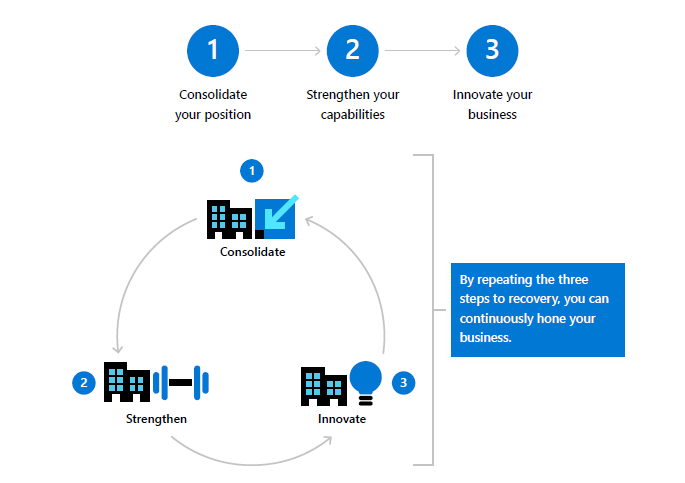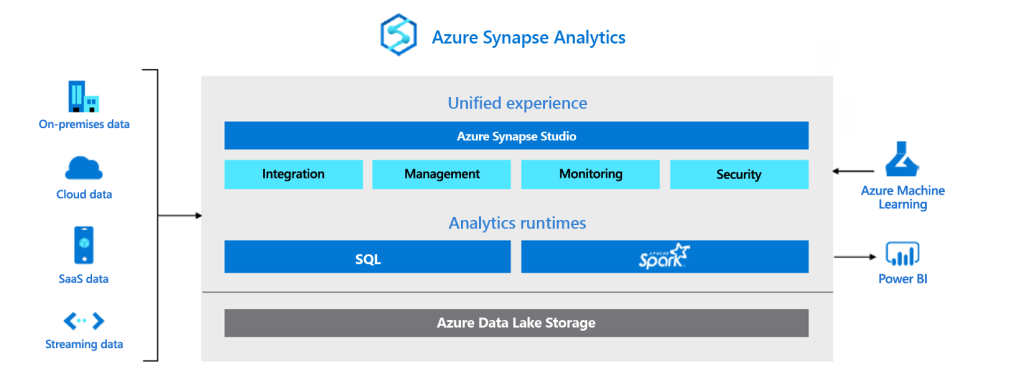Agility is no longer nice to have
2020 changed our world. In our personal lives, our business lives and our economy, we have had to adopt new behaviours. Some sectors such as travel, hospitality, entertainment and education have restructured dramatically. In every walk of life, these new processes, practices and habits are still in flux.
Moving forward in this landscape calls for fresh strategies, especially to develop an alert, responsive organisations. Wherever you were in your digital transformation before, your recovery and growth now rely on developing a long-term plan that embraces remote workers, giving them the tools and data they need, wherever they are, to experiment, to respond and to collaborate.
In this post, we will define three phases of recovery. We’ll explore how Azure Synapse Analytics can help you drive better business outcomes in the face of today’s new, constantly challenging world.
Build resilience into your operations with cloud analytics
• Access a seamless, ready-to-use, continuum of technologies and tools to realise value faster
• Provide insights from machine learning and AI for everyone even without a data science team
• Run your business governance with constantly monitored and updated enterprise-grade security and compliance
• Shift spending from CapEx to OpEx and reduce your infrastructure maintenance
Move from recovery to growth in three phases
In this new economy, you walk a fine line between embracing what works for you today and investing for tomorrow. With the right analytics, you can find your balance, at first consolidating, then strengthening your current capabilities, ultimately enabling greater innovation and coming out ahead.

With Azure Synapse Analytics you can respond intelligently and effectively, adapt to the new business landscape and save on costs. Azure Synapse enables a continuum of analytics relevant to everyone, from the operational business user to the most strategic executive and most technical data scientist. Power BI users, for example, will find boundless data and compute resources to help generate in-the-moment insights without needing constant support from IT.
Phase One:
Consolidate your position
Most businesses build growth projections for years ahead based on dynamic models of continuous progress. Given disruptions to employees, customers and the market, every model, every budget and every sales pipeline has changed. Teams urgently need to reassess their plans in the face of this reality and focus on what matters most today.
The first step in building your recovery plan is to consolidate your position and protect whatever is working for you just now. For many companies, this will mean making trade-offs between looking for new business opportunities and reinvesting in core strengths. A good place to start is by thinking through the following questions:
• What is your most important business goal over the next six, 12, 18 months?
• What are your advantages in people, connections or flexibility in the context of the new market?
• What data systems do you have in place that can help you attain your goals?
• How do those systems support the longer-term business outcomes you want to achieve?
• What core business values do you hold and how do they shape your future?
For example, if your organisation operates on-premises and your goal is to keep smart employees engaged and motivated during an indefinite work-from-home period, you need to make sure they can easily access the data and real-time insights they need to make business decisions. You can do this by consolidating your current data estate into a single cloud-based location on Azure Synapse Analytics.
Azure Synapse provides enterprise-grade security and higher performance at a lower total cost, so this move is more than just a convenience – it offers real advantages now. With advanced features such as machine learning and AI built-in to the heart of Azure Synapse, there are also tremendous opportunities to grow into the future.
For business leaders who know that both systems and ethos are essential to success, moving to a cloud-based service helps strengthen employees’ engagement and productivity, and also opens the door to analytics as a business practice rather than just an IT function. In short, a move to Azure Synapse enables cultural change as much as operational improvement
Phase Two:
Strengthen your capabilities
In the second phase, your aim is to bring together the advantages you identified and consolidated in phase one and get better at using them. Too many businesses in a crisis rush into trying new ideas, but first, it is hugely valuable to ensure you are getting the best from your current capabilities. In this way, the outcome from phase two is a crucial bridge between core business activities and growth that helps to future-proof your business.
How you strengthen your capabilities and build this bridge depends on both what is working today and your future goals. The following questions should help you explore what is possible:
• Who in your team today is able to deliver actionable business insights? E.g. developers with advanced SQL skills or BI users who are great at building visualisations
• What core activities drive your business? How could you enhance those? E.g. today the customer support desk triages calls to business groups. With better business insight, they could resolve more issues without handing off the calls.
• How might your team abilities extend and complement your core activities? For E.g. SQL developers could create a predictive analytics dashboard that the support team can use to proactively address issues before they arise. BI users could share visualisations with the support desk to give them more context on trends and important issues in the business.
• What core activities are well established in your business? E.g. today CRM processes
capture customer interactions, but there’s no strategy for decreasing the average number
of interactions that go into a sale.
Once you have ideas about how you might strengthen your capabilities, you will want to evaluate your tools and platforms to determine if you have the right systems in place to enact them.
Azure Synapse brings together enterprise data warehousing and big data analytics into a unified experience through a single platform that consists of deeply integrated Apache Spark and SQL engines. So you can support your SQL developers, your BI teams and data scientists with a shared, consistent, well-governed data infrastructure.
For business leaders, this means you don’t need to retrain staff or hire new skills. Your teams can build on their existing skills and cross-fertilise ideas, such as bringing together big data and customer transaction data.
Phase Three:
Innovate your business
Now, having consolidated and strengthened your existing advantages, moving from recovery to growth picks up pace, creating net new value and potentially changing your core business model.
The ease with which you innovate your business will depend on how effectively you have strengthened your capabilities in previous phases. To look for new opportunities, consider the following questions:
• What does it mean for your business if you change the answer to some basic questions: who, what, when, where, why or how? For example, where do you do business? In a store, with customers in person? Online, though an eCommerce offering? Or you could answer Who in a new way – the shift from B2B to B2C, for example, can be radical, innovative and re-energising.
• What new activities are enabled by the changes you made in phases one and two?
E.g. a unified analytics platform like Azure Synapse enables an omnichannel marketing experience by unifying data from all the different sources.
• Which activities would be most critical for a new business direction? If you want to develop your online presence, you might set up marketing analytics for personalisation, customer segmentation and cross-sell/up-sell promotions, seeing these as much more critical for online commerce than in-store.
As a platform for innovation, Azure Synapse deeply integrates with Power BI and Azure Machine Learning. The continuum of analytics in Azure Synapse reduces development time for BI and machine learning projects. You can develop insights of wider scope and greater depth from all your data and deploy machine learning into dashboards and intelligent apps, with integration over all your most important data – from Dynamics 365, Office 365, to SaaS services that support the Open Data Initiative.
From the perspective of the C-suite, these technical advantages result in greater agility and greater innovation because the latest technologies work on data from many different products and platforms.
These structured phases and questions naturally lead to a lot of scenarios. You will want to continuously test and challenge them as you innovate to better understand how they work for your specific goals. Right now, your priority should be to evaluate your teams and systems to see how many scenarios you could support down the road (the more different the scenarios are from one another, the better). The goal is to ensure that the investments you make in phase one continue to open doors for you through phase three with minimal friction.
“Azure Synapse Analytics enabled us to create a platform that is streamlined, scalable, elastic and cost-effective, enabling my business users to make the right decisions for the fast-paced market.” – famous quote
This is how Azure Synapse Analytics is engineered to shorten the path from data to business insights:





